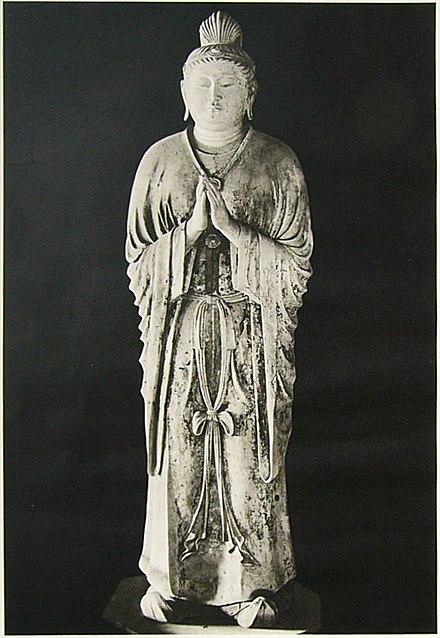Candraprabha
Bodhisattva
| Candraprabha | |
|---|---|
 Candraprabha, Tiantan Garden, Shantou | |
| Sanskrit | चन्द्रप्रभ
Candraprabha |
| Chinese | 月光菩薩 (Pinyin: Yuèguāng Púsà) 月光遍照菩薩 (Pinyin: Yuèguāng Biànzhào Púsà)) 月光普照菩薩 (Pinyin: Yuèguāng Pǔzhào Púsà) 月净菩薩 (Pinyin: Yuèyào Púsà |
| Japanese | 月光菩薩 (romaji: Gakkō Bosatsu or Gekkō Bosatsu) 月光遍照菩薩 (romaji: Gakkō Henjō Bosatsu) 月光王菩薩 (romaji: Gakkō Ō Bosatsu) 月浄菩薩 (romaji: Getsujō Bosatsu) |
| Khmer | ចន្ទ្រប្រភា (chan-pra-phiea) |
| Korean | 월광보살 (RR: Wolgwang Bosal) 월광변조보살 (RR: Wolgwang Byeonjo Bosal) 월정보살 (RR: Woljaeng Bosal) |
| Tagalog | Candlaplabha |
| Thai | พระจันทรประภาโพธิสัตว์ |
| Tibetan | ཟླ་འོད་ Wylie: zla 'od THL: da ö |
| Vietnamese | Nguyệt Quang Bồ Tát |
| Information | |
| Venerated by | Mahayana, Vajrayana
|

Candraprabha (lit. 'Moonlight', Chinese: 月光菩薩; pinyin: Yuèguāng Púsà; Rōmaji: Gakkō or Gekkō Bosatsu) is a bodhisattva often seen with Sūryaprabha, as the two siblings serve Bhaiṣajyaguru.[1] Statues of Candraprabha and Sūryaprabha closely resemble each other and are commonly found together, sometimes flanking temple doors. They are also recognized in mainland Asia as devas.
See also
References
This Buddhist mythology-related article is a stub. You can help Wikipedia by expanding it. |
Retrieved from "https://en.wikipedia.org/w/index.php?title=Candraprabha&oldid=1179026053"
